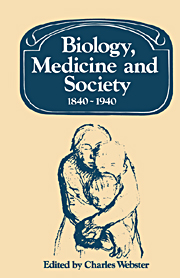Book contents
- Frontmatter
- Contents
- Contributors
- Preface and Acknowledgements
- Introduction
- 1 Women's Health and the Women's Movement in Britain: 1840–1940
- 2 Working-Class Mothers and Infant Mortality in England, 1895–1914
- 3 Theories of the Cell State in Imperial Germany
- 4 Innate Character in Animals and Man: A Perspective on the Origins of Ethology
- 5 Genetics in the United States and Great Britain 1890–1930: A Review with Speculations
- 6 Eugenics and Class
- 7 Sociobiologies in Competition: The Biometrician–Mendelian Debate
- 8 Psychologists and Class
- 9 Measuring Intelligence: English Local Education Authorities and Mental Testing 1919–1939
- Index
5 - Genetics in the United States and Great Britain 1890–1930: A Review with Speculations
Published online by Cambridge University Press: 02 December 2009
- Frontmatter
- Contents
- Contributors
- Preface and Acknowledgements
- Introduction
- 1 Women's Health and the Women's Movement in Britain: 1840–1940
- 2 Working-Class Mothers and Infant Mortality in England, 1895–1914
- 3 Theories of the Cell State in Imperial Germany
- 4 Innate Character in Animals and Man: A Perspective on the Origins of Ethology
- 5 Genetics in the United States and Great Britain 1890–1930: A Review with Speculations
- 6 Eugenics and Class
- 7 Sociobiologies in Competition: The Biometrician–Mendelian Debate
- 8 Psychologists and Class
- 9 Measuring Intelligence: English Local Education Authorities and Mental Testing 1919–1939
- Index
Summary
In the last fifteen years, a rich body of historical scholarship has been published in the early history of genetics. Drawing upon the extensive manuscript collections becoming ever more available, this literature has focused on the emergence of the discipline from evolutionary biology and has given provocative attention to the celebrated dispute between the advocates of the then-competing paradigms of hereditary science – biometry and Mendelism. Indispensable so far as it goes, the existing historiography nevertheless omits approaches and subjects whose fruitfulness historians of science are, increasingly, coming to recognize. With some exceptions, the literature of genetics covers its various topics in either the United States or England but not cross-nationally. Moreover, most of the scholarship does not go much beyond treatments of the principal actors or conceptual developments. Certainly it leaves unexplored the history of the overall corps of men and women, including the scientific commoners in research, who came to form the Anglo-American genetics community. It is the aim of this review, which brings to bear upon the literature both manuscript sources and a transatlantic perspective, to suggest that making up for these deficiencies would be worthwhile and, in certain respects, is necessary.
To summarize the recent scholarship, by the 1890s many younger biologists were growing restless with phylogenetic morphology and embryology, the traditional descriptive approaches to the much-debated problems of evolutionary theory. Eager to break away from these approaches, a number of these biologists – and some older ones such as Alfred R. Wallace – called for programs of quantitative or experimental research in evolution addressed in particular to the problems of heredity and variation.
- Type
- Chapter
- Information
- Biology, Medicine and Society 1840–1940 , pp. 193 - 216Publisher: Cambridge University PressPrint publication year: 1981
- 5
- Cited by



